Philadelphia 2017
The state of the city
Considering all that has happened in Philadelphia over the past several years, it is difficult to find a single statistical indicator that best captures the state of the city in 2017.
Is it 10 straight years of modest population increases, producing a more diverse and vibrant community? Is it Philadelphia’s solid, if not dynamic, rate of job growth? An unemployment rate that remains stubbornly high, even with the additional jobs? Or a poverty rate that has not dropped in any significant way?
Philadelphians appear to be more comfortable with their city’s increased vitality, despite its long-term problems. When polled by Pew in August 2016, residents were more inclined to see the city as heading in the right direction than at any time in the seven years of the poll’s existence.
On Philadelphia's Population:
There are plenty of positive developments to support that view led by the higher population. Although the cumulative growth in the past 10 years has amounted to little more than 5 percent, Philadelphia’s head count is as large as it has been in nearly a quarter-century.
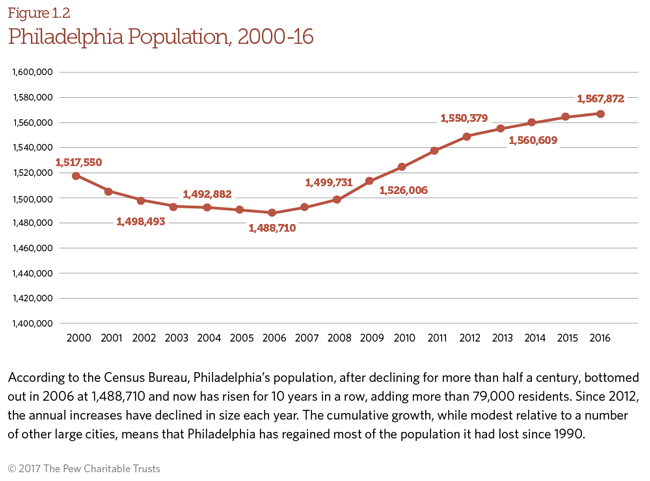
- Data Point
Tweet
79,000 Increase in Philadelphia’s population 2006-16.
On the Economy:
The recent economic data have been particularly strong. The job market has expanded, adding 40,000 positions in the past five years; in 2016, Philadelphia outperformed the nation as a whole in job growth for the first time since the Great Recession. The rise in median household income for city residents outpaced the nation as well, up more than 5 percent in a single year. The residential construction boom, while slowing, has life in it yet, and home sale prices have risen 38 percent since 2010.
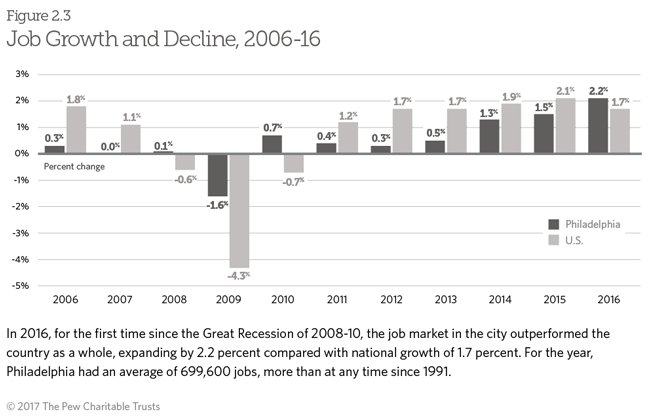
- Data Point
Tweet
2.2% Philadelphia’s job growth in 2016, compared with the national growth of 1.7 percent.
On Public Safety:
In addition, the city has become safer. Major crimes declined again in 2016, dropping to levels not seen in decades. In the past several years, deaths from homicides, fires, and traffic accidents have been at or near historic lows, and infant mortality has fallen as well.
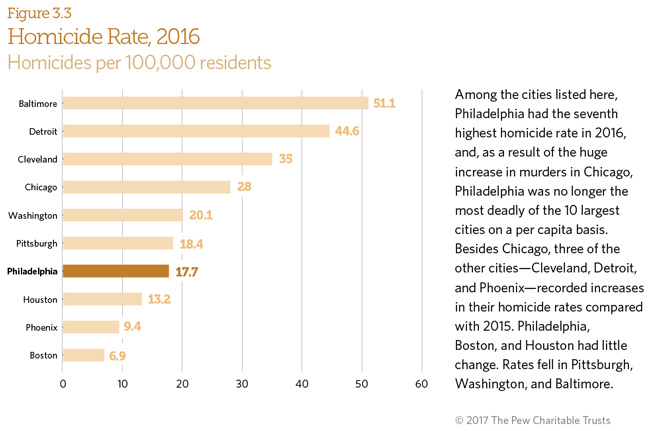
- Data Point
Tweet
17.7 Homicides in Philadelphia per 100,000 residents in 2016, lower than many comparable cities including Pittsburgh and Washington.
On Poverty:
But the city’s deep and chronic problems remain. Even with the relatively strong economy of the past few years, more than a quarter of city residents still live below the poverty line, and Philadelphia has been unable to shake its title as the poorest of the nation’s 10 largest cities.
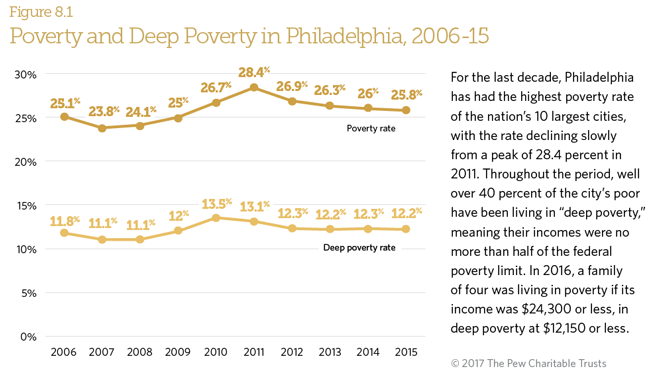
- Data Point
Tweet
25.8% Philadelphia’s poverty rate in 2015. That same year, 12.2% of the city lived in deep poverty, with incomes under 50% of the federal poverty limit.
On Unemployment:
Despite the recent job growth, the unemployment rate for city residents was 6.8 percent in 2016, nearly 2 percentage points above the national average and higher than in Chicago, Baltimore, Washington, and Pittsburgh, among others. The percentage of adult Philadelphians not working or looking for work remained at 31 percent, 7 percentage points above the national average.
On Housing:
And with housing costs on the rise, 56 percent of residents were paying 30 percent or more of their incomes for places to live.
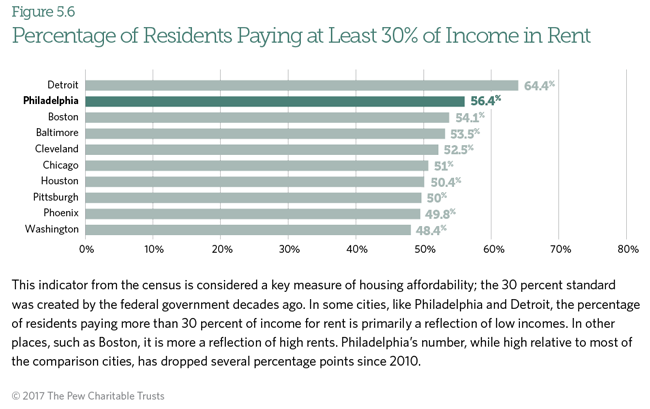
- Data Point
Tweet
56.4% Share of Philadelphians paying at least 30% of their income on rent, primarily a reflection of low incomes, rather than high rents.
On Health and Welfare:
Another disturbing trend has been the increase in the number of deaths by accidental drug overdoses, which is a national problem as well. City officials said the unofficial total of such fatalities in Philadelphia approached 900 in 2016, nearly triple what it had been a decade ago.
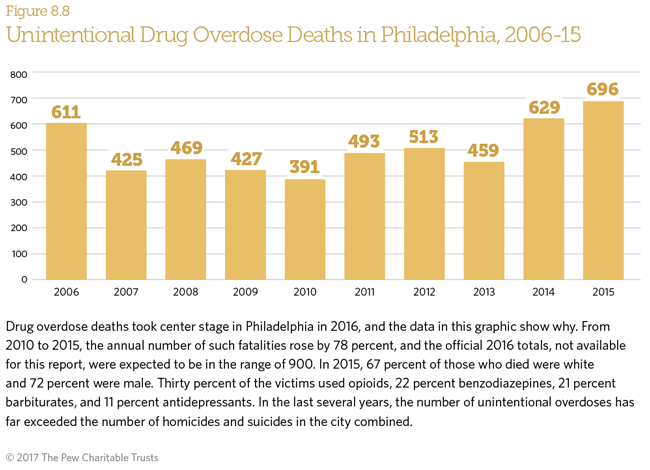
- Data Point
Tweet
696 Number of Philadelphians who died of unintentional drug overdoses in 2015, an increase of 78% since 2010. In 2016 the number of such deaths was approximately 900, based on unofficial estimates.
On Education:
Although the percentage of adult Philadelphians with college degrees grew, the citywide figure remains far below those of other major cities along the East Coast. The public schools are not facing an immediate fiscal crisis, but they are still seen as low-quality by the vast majority of city residents.
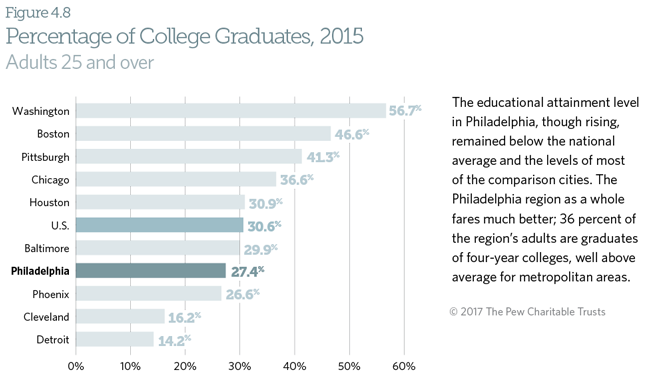
- Data Point
Tweet
27.4% Share of Philadelphians with bachelor’s degrees in 2015, lower than the national average.
On City Government:
And City Hall’s long-term ability to address these and other challenges is threatened by the unfunded liability in the pension funds for municipal workers, recently calculated at nearly $6 billion.
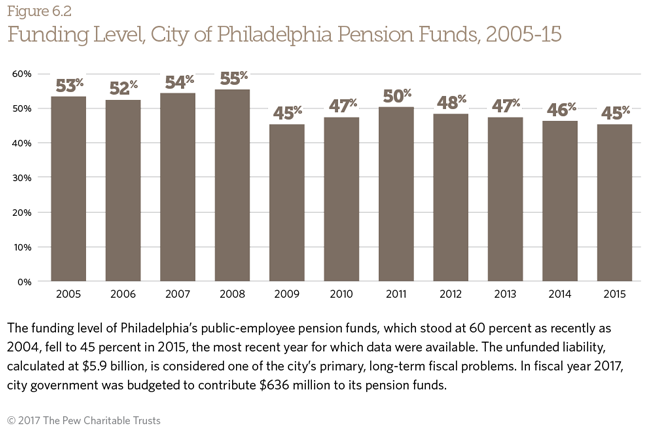
- Data Point
Tweet
$5.9 billion The unfunded liability of Philadelphia’s public-employee pension funds, considered one of the city’s primary, long-term fiscal issues.
On Demographics:
Over the past decade, Philadelphia’s growth and revival have been fueled by immigrants and young adults. But that dynamic could be changing: The nation’s immigration policy is in flux; the coming generation of young adults is a little smaller than the current one; and some local millennials, those with young children, are faced with the decision of whether to raise their families in the city or head for the suburbs.
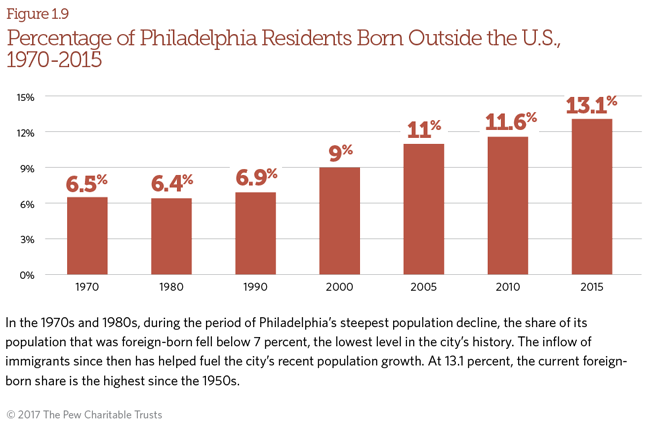
- Data Point
Tweet
13.1% Share of Philadelphia residents born outside of the U.S. in 2015, up from 6.5% in 1970.
For these stats and more, explained in over 80 charts, graphs, and maps, download the full report.







